Mark Sisson's Blog, page 343
April 8, 2013
Dear Mark: ApoE4, Red Eye Recovery, TEDx Paleo Debunking, and Cough Drops
 It’s Monday, which means it’s time for another edition of Dear Mark. This week, I’m covering four reader questions. First up is a really tricky one: ApoE4, the ancestral allele that’s classically associated with a host of maladies, like cardiovascular disease and Alzheimer’s. What’s the deal with it? We don’t have any concrete answers (yet), but I give my take on it. Next, I tell a reader who’s flying to Chile for vacation how I recover from travel-related sleep disturbances and realign my circadian rhythm. After that, I cover another paleo debunking that’s actually not much of a debunking, this time a TEDx video from Christina Warriner. And finally, I explore the eternal question of Halls cough drops, including whether or not any natural alternatives exist.
It’s Monday, which means it’s time for another edition of Dear Mark. This week, I’m covering four reader questions. First up is a really tricky one: ApoE4, the ancestral allele that’s classically associated with a host of maladies, like cardiovascular disease and Alzheimer’s. What’s the deal with it? We don’t have any concrete answers (yet), but I give my take on it. Next, I tell a reader who’s flying to Chile for vacation how I recover from travel-related sleep disturbances and realign my circadian rhythm. After that, I cover another paleo debunking that’s actually not much of a debunking, this time a TEDx video from Christina Warriner. And finally, I explore the eternal question of Halls cough drops, including whether or not any natural alternatives exist.
Let’s go.

Hi Mark and Worker Bees,
I read that APOE4 is the “ancestral” allele for the APOE genes. It is the risk factor for Alzheimer’s. I find it hard to believe that checking out mentally is in any way desirable. You linked a few months ago to an interesting article about high-carb seniors succumbing to cognitive impairment. Might you be able to think aloud about this topic?
Joy
ApoE is apolipoprotein E, the string of amino acids that attaches to lipoproteins and allows them to cross the blood-brain barrier and get into the brain to deliver nutrients and cholesterol and remove toxins. If a lipoprotein has the ApoE marker, it will be allowed into the brain to do its work. Different genetic variants of ApoE are better and worse at this task, however.
ApoE2, is associated with a lesser risk of Alzheimer’s and ApoE3 is “neutral.” Meanwhile, ApoE4 is associated with higher total cholesterol and a greater risk of Alzheimer’s. Thus, most people assume that the high cholesterol is also causing the Alzheimer’s and dementia. It’s not quite so simple, of course.
Brain is perhaps the richest source of cholesterol in all the land (or sea); just an ounce of raw lamb brain contains nearly 400 mg of cholesterol. In fact, brains – living ones – need plenty of cholesterol to work right. The synapses, or connections between neurons, are made of cholesterol. In case our brains aren’t getting enough cholesterol, the astrocytes – brain cells which supply nutrients to neurons – can even manufacture their own cholesterol.
That may explain why statins can hamper brain function, why high cholesterol late in life is associated with a reduced risk of dementia, and why Alzheimer’s patients have lower levels of cholesterol, phospholipids, and fat in their cerebrospinal fluid. Clearly, our brains need cholesterol.
So why is ApoE4 associated with high cholesterol and Alzheimer’s?
One hypothesis is that people with ApoE4 need higher baseline plasma lipids because ApoE4 makes the brain less efficient at taking up cholesterol. If that’s true, high cholesterol may be a protective mechanism designed to overcome this limitation. This would jibe with the observation that Alzheimer’s and dementia are often preceded by a big drop in cholesterol. That is, the early, asymptomatic stages of Alzheimer’s are associated with a decline in serum total cholesterol, not a rise. Interestingly, young ApoE4 carriers have better memory, better learning capacities, and more neural efficiency in general than non carriers, so it’s not all bad. Something goes wrong down the line.
My take is that ApoE4 carriers, being “ancestral,” are simply more susceptible to neolithic stressors like tobacco (yeah, yeah, I know it’s been smoked for a long time, but not in its current form), heavy metal toxicity, sedentary living, and chronic stress. Some evidence:
When you remove tobacco smoking, the association between ApoE4 and cardiovascular disease disappears. Another study had similar results, finding that only smoking ApoE4s had increased levels of oxidized LDL and lower levels of antioxidants.
Among the ApoE alleles, ApoE4 is the worst at binding heavy metals, including (at least) mercury (PDF) and copper. Ancestral populations weren’t sporting mercury amalgams in their mouths or relying on coal-fired power plants, so heavy metals weren’t really much of a selective pressure.
For ApoE4 carriers, being sedentary is far more dangerous than it is for carriers of other alleles.
In older adults with ApoE4, chronic stress results in higher cortisol and greater losses in memory. ApoE4 carriers are also more likely to develop depression from chronic stress.
I’d also guess that a bit of intermittent fasting, or at least a movement away from the wholly modern grazing method of eating, would also be helpful. At any rate, closer adherence to a Primal way of life appears especially crucial for ApoE4 carriers.
Another view is that ApoE4 carriers are actually more sensitive to dietary fat, particularly saturated fat, as well as carbohydrate. William Davis MD has found that for these individuals, moderation of both fat and carbs is necessary to avoid elevations in the number of LDL particles, particularly small dense LDL. ApoE4s should probably at least monitor their lipids and spring for the more advanced tests to note how fat and SFA affect LDL-P, LDL-C, and small dense LDL – just to be safe.
Mark,
I’m leaving for a vacation to Chile later this week and I’m facing 2 overnight flights within 10 days of each other.
I’m about 6’2″, broad shouldered, and for the time being my pocketbook precludes me from sitting in the pointy end of the plane.
This upcoming flight has me wondering what tips and/or advice you have for people who are facing a situation with non-ideal sleeping conditions? What can be done in advance from an exercise/nutrition/supplementation standpoint to partially mitigate the effects of poor sleep?
Also, do you have any suggestions for things that can be done to promote better sleep in a tight spot (no pun intended!)?
Thanks for everything you do with this site. Look forward to your suggestions.
T
As a frequent traveler, I’ve figured out a perfect regimen for getting my clock aligned with wherever I’m staying. It may not work for you, but it certainly does for me and pretty much everyone else to whom I’ve suggested it.
On overnight flights going East, you’ll be experiencing what amounts to two “shortened days” as you erase multiple time zones from you diurnal rhythm overnight. Set your watch to your new intended time zone when you are in the air. Get as much sleep as you can on the plane. Typically you’ll arrive sometime later in the day at your destination, so you won’t have to work hard to stay awake, but do so. You got 4-6 hours on the plane maybe, but the new “day” will be several hours shorter. Adapt your mindset to the new time zone immediately. Do NOT nap. I usually go for a short walk to explore the city or I hit the gym and ride the bike a bit. As it gets close to the new bed time, try to take 3-5 mgs of melatonin an hour before your intended bedtime. By the time you hit the hay, it will have done a decent job resetting you internal clock and allowing to get some regular zzz’s. Repeat the melatonin ritual the next night and then cut in half the third night. From there you should be good to go.
Now, for Westbound flights that follow the daylight most or all of the way, you will be experiencing a very long single day and usually arriving towards the end of that day. In this case, same thing, set your watch on the plane to “get into” the new time zone. Stay awake as you see fit, but try to take a long nap maybe halfway through the flight. You will have rested, but not have had too much sleep that it throws your normal night off. When you arrive, same process, stay awake until it’s the local bedtime, find things to do, take a hike or work out, and do the same melatonin ritual.
Finally, for long night flights, just get as much sleep on the plane as you comfortably can, because you’ll have a long day at your destination. I try to do two naps with a few movies in between.
To sleep on the plane itself, I have a few suggestions:
Get a window seat. I know the aisle offers more legroom, but it’s hard to get comfortable when you have to worry about where to put your head. With a window seat, you can wedge yourself up against the side of the plane. Plus you won’t have people crawling over you to get to the bathroom.
Get an exit row. More legroom is always better.
Consult Seat Guru. Figure out what model plane you’ll be on and then check reader reviews to find the best seat in the house.
Bring a pillow if the airline doesn’t provide one. I like a super compact backpacking pillow, the kind you’ll find at REI. Barring that, a rolled up article of clothing works.
Hey Mark, big fan of this site.
Have you seen this TED talk by Christina who claims to debunk your theory and other Paleo like diets? She does a lot of fad calling, showing your books and movement a fad.
Check out the talk when you have the time and please, as your readers, we’d all like to see a post on your thoughts around this. She has left a lot unsaid and I’m wondering if she’s even read any of the books she’s talking about.
Madelain
I have seen it. It was better than Paleofantasy, but it suffered from some of the same mistakes. Mainly, she didn’t really do her homework and ends up promoting a fairly Primal way of eating without actually realizing it. It’s just that the first five or six minutes are really rough.
She begins by saying that humans have no anatomical or physiological adaptation to eating meat, meaning (I assume) because we don’t have big scary claws and teeth and the ability to overpower and devour a bison barehanded, we aren’t “meant” to eat animals. On some level, this makes sense. Dogs, cats, lions, tigers, and other fearsome predators all come equipped with the physical, mechanical equipment to break down and consume a carcass. Humans do not. We do, however, have technology. We have spears, stone knives, bows, atlatls, slingshots, and, now, rifles, to kill and butcher our prey. We’ve harnessed fire to cook it. We’ve also harnessed fire to cook starch, which – unlike meat – we actually have to cook in order to really digest. Why no mention of that in the video?
That said, despite the pretty obvious vegetarian bias (“paleo is for men,” “paleo is all about meat,” etc), the rest of the talk is good. She ends by acknowledging that we can learn a few things from paleolithic nutrition: eat fresh foods; eat whole foods; and eat high species diversity. Oh, and don’t eat refined sugary drinks. I agree with her on all these points. I think if she read through this blog she’d agree with most of mine.
Robb Wolf gave a good minute by minute summary (a Wolf’s Eye View) that I’d recommend reading. I agree with everything he says in it.
Dear Mark,
I have need for a cough drop for nighttime sleeping or when attending an event requiring quiet. I just looked at the ingredients in the 5 bags of Halls my hubby bought and it’s almost all sugar and junk. What would you recommend especially now that I’m on 21-day Sugar DeTox? Help! :)
Currently, I have 2 cloves of clove in my mouth guessing this may help! ??
Thanks,
Jo
I wasn’t really able to find any natural cough remedies with strong evidence. If natural methods aren’t working, a single Halls cough drop only has about 4 grams of sugar, mostly glucose (from glucose syrup). Unless you’re really wedded to this 21-day detox, I’d say just go ahead and take the cough drop. Besides, the 21-day sugar detox is more about avoiding sweets – elective junk food – than eliminating every trace molecule of sugar, which in this case is primarily glucose rather than fructose. One study even found that both menthol and a sweet taste are effective at suppressing coughs, so combining the two is likely more effective than either alone.
A bad night’s sleep is way, way more detrimental to your health than a tiny bit of sugar:
A single night of partial sleep deprivation induced insulin resistance via multiple metabolic pathways.
Four nights of bad sleep caused women to eat more and gain weight. Same goes for men after just one night.
Partial sleep deprivation decreases endothelial function.
Bad sleep reduces your tolerance of stress.
And those are just a few examples.
Both honey and chocolate may be effective against coughs, but, well, those aren’t exactly sugar-free.
That’s it for today, guys. Thanks for reading and be sure to chime in with your thoughts/opinions/suggestions in the comment section!
Get All Three Primal Cookbooks, an Apron and More in The Primal Blueprint Chef Kit Today!

April 7, 2013
Weekend Link Love

The Primal Life Kit is still available. If you enjoy obtaining reams of valuable ($485 worth) knowledge (including a month’s subscription to my own Primal Blueprint Meal Plan service) for cut-rate prices (just $39), you will like the Kit. Buy it.
Research of the Week
Got brain drain? Go for a walk in the park.
Is “salt-sensitive” hypertension just glucose intolerance in disguise?
Three whole eggs a day is just what the cardiologist ordered.
Interesting Blog Posts
How America’s oldest living person – until recently – lived so long.
BoingBoing picked up my Paleofantasy review.
Media, Schmedia
Genetically modified wheat (coming soon to a store near you!) may silence vital human genes, according to research by a professor of microbial genetics (PDF). Of course, to do that, the relevant compounds will have to make it through the gut wall and into the bloodstream to interact with our genes, which wheat has never, ever been shown to do. Right? Right?
When normal people are faced with the consequences of their decisions or actions, they have to own up to it. When Monsanto is faced with independent research that their actions might be killing the bees en masse, it simply buys the research firm that implicates them. And no, this is not an Onion article.
Everything Else
Recipe Corner
Tod man pla (no, that’s not a typo).
We all need more shellfish in our lives. Why not go all out and make some magic shrimp?
Time Capsule
One year ago (Apr 7 – Apr 13)
The Definitive Guide to Traditional Food Preparation and Preservation – How’d they do it in the old days?
The Importance of Pull-up Bar Training – Bar calisthenics expert Al Kavadlo explains why you need to be working with an elevated horizontal bar capable of supporting your body weight.
Comment of the Week
Had to laugh!
“A big paleofantasy. I could be making this entire world up in my head as I go along.”
……Being Mark Sissonvich…..
- I’d watch that.
Get All Three Primal Cookbooks, an Apron and More in The Primal Blueprint Chef Kit Today!

April 6, 2013
Head Cheese
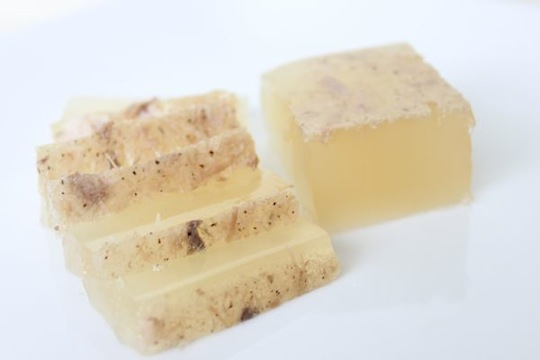 Head cheese is not cheese at all, and these days it’s not always made from meat simmered off the head of a pig. A more accurate and appetizing way to think of head cheese is simply that it’s a cold cut made from tender, fatty pork.
Head cheese is not cheese at all, and these days it’s not always made from meat simmered off the head of a pig. A more accurate and appetizing way to think of head cheese is simply that it’s a cold cut made from tender, fatty pork.
Head cheese isn’t hard to make at home, especially if you have a pressure cooker and use pig’s feet instead of a pig’s head. A pressure cooker completes the simmering process in 1 hour, rather than 3 or 4. And pig’s feet are easier to find than a whole pig’s head (and there’s a little less of a gross-out factor if you’re squeamish). Hispanic supermarkets almost always sell pig’s feet, or you can special order them from a butcher or local farm.
Pig’s feet are inexpensive and the perfect addition not only to head cheese, but to any stock. The skin, joints and bones release tons of healthy collagen, giving the simmering liquid texture and helping it firm up when chilled.
When cooking head cheese at home, you can control the texture and flavor, making it meatier or more gelatinous, seasoned heavily with spices or hardly at all. The head cheese in this recipe photo is light on meat, resulting in a smoother melt-in-your-mouth texture. Most people, however, prefer a meatier mix, and that’s what you’ll get if you add all of the meat from the recipe below.
This recipe for head cheese takes some time but very little effort. Mostly, it’s about simmering and refrigerating. For some, head cheese is a nostalgic treat. For others, it’s an adventurous and surprisingly tasty way to embrace gelatinous food.
Serves: 8
Time in the Kitchen: 1 hour of simmering, plus 8 hours of refrigeration
Ingredients:

4 to 6 pig’s feet
2 pounds of a bone-in, inexpensive cut of pork (ribs, roast, un-smoked ham hocks) (900 g)
1/4 cup apple cider vinegar (60 ml)
Salt and pepper
Instructions:
Wash the pig’s feet, making sure to remove any hair that remains by scraping it off with a knife.
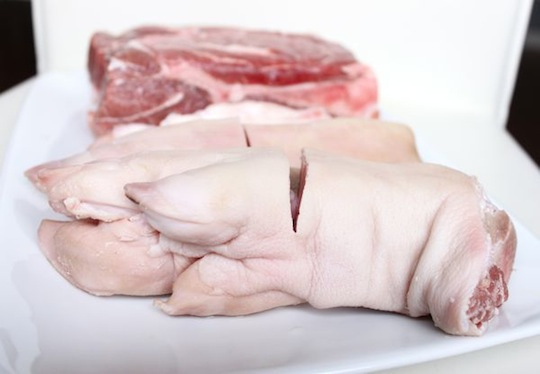
Put the feet and the other cut of pork in a pressure cooker with the vinegar, a generous pinch of salt and pepper and just enough cold water to cover everything. You can also add bay leaves, peppercorns, allspice and other spices to the pot if you like.
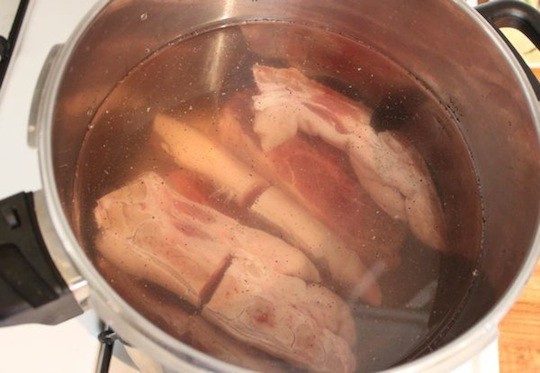
Cook in the pressure cooker for 1 hour. If you don’t have a pressure cooker, then simmer in a pot until the meat is fork-tender, about 3 to 4 hours.
Strain the solids (meat, fat, bones) from the liquid (save the liquid!)
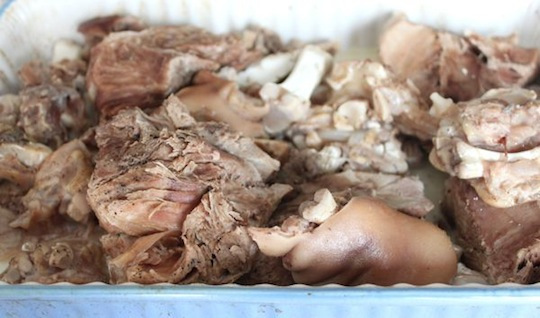
Put the solids on a plate or cutting board to cool and then separate all the meat and fatty bits from the bones and chop it up fine. If the really fatty pieces aren’t appetizing you can throw some out, but don’t go overboard or you’ll lose all the good stuff.
Generously season the meat with salt and pepper to taste.
Add as much of the cut up meat as desired back into the broth and pour it into a 9 x 13 cake pan.
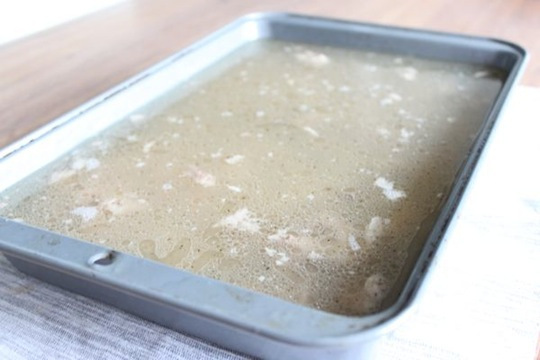
The mixture can also be poured into terrine or loaf pans filled 1/2 to 3/4 full.
Loosely cover the mixture of meat and broth and let the head cheese firm up in the refrigerator for at least 8 hours.
After the head cheese has set, use a spoon to scrap off and discard any white fat that has come to the surface. At this point the head cheese is done, but if the texture is too soft for your liking, then put it back into a pot and simmer, uncovered, for about 30 minutes. Return the mixture to the refrigerator to cool and set again.
When it is cooled and set, cut the head cheese into slices or squares and serve.
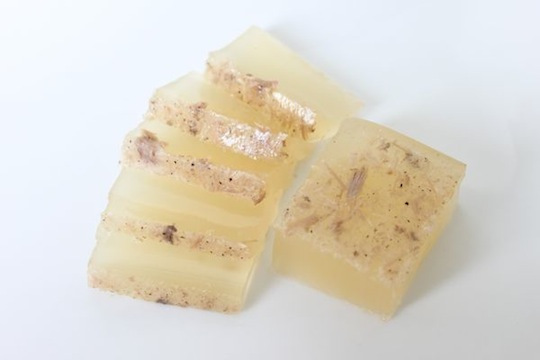
Recipe Notes
A pressure cooker extracts more gelatin in a shorter amount of time than simmering in a pot does. If you’re not using a pressure cooker for this recipe it’s very likely you’ll have to simmer the mixture again after the first refrigeration.
Whether or not a pressure cooker is used, the head cheese can always be firmed up by adding powdered gelatin to the broth and meat mixture before refrigerating it. The head cheese in the photo has had powdered gelatin added. However, if you use enough pigs feet (make sure to use at least 4 feet) then adding powdered gelatin shouldn’t be necessary.
Not Sure What to Eat? Get the Primal Blueprint Meal Plan for Shopping Lists and Recipes Delivered Directly to Your Inbox Each Week

April 5, 2013
The Pain and Stiffness Disappeared and Has Never Returned
It’s Friday, everyone! And that means another Primal Blueprint Real Life Story from a Mark’s Daily Apple reader. If you have your own success story and would like to share it with me and the Mark’s Daily Apple community please contact me here. I’ll continue to publish these each Friday as long as they keep coming in. Thank you for reading!
 Dear Mark,
Dear Mark,
Although you are totally unaware of it, you and I just celebrated our second anniversary. It was two years ago, February of 2011, that I was introduced to you. At the time, you were nothing but an experiment, a fling if you will, but now you are among the most important men in my life. No, I’m not really flirting with you. I’m a 54 year old teacher from the Midwest, married, mother of four and grandmother of two. But now that I have your attention, here’s the rather unremarkable story of my two-year Primal journey.
I’ve always had an interest in healthy eating and fitness. I have read most of the books, tried a lot of diets, and done a variety of fitness activities, and every one of them ran its course to be followed by something new. Two years ago my older son, Adam, started telling me about this blog he was reading where this guy had ten basic rules for living like the cavemen lived. He was intrigued and was set to try the eating plan as an experiment for Lent. I thought I might just give it a try as well. Adam is a high school science teacher, so all the science information he’d been reading on this blog really clicked with him. I’m an English teacher, so I skimmed the science and paid close attention to the summarizing paragraph and asked my son a lot of questions. I downloaded The Primal Blueprint and read it immediately as well as spending a lot of time on Mark’s Daily Apple. Since I was in the Lenten mode of self-sacrifice, the new eating style really came pretty easily. Then came Easter. My time of “sacrifice” was ended, but I no longer felt like I was sacrificing anything. By then it was my new lifestyle.
Bear in mind, that the Primal lifestyle was basically an experiment for me; I had no real goals for weight loss or improved health. I just wanted to see what it was like and what might happen. I was not particularly overweight – 5’5 ½” tall, about 145 pounds, size 8. But after a few weeks, pounds started dropping off, and the little aches and pains I had been noticing disappeared. I never realized how bloated I felt until the feeling was gone. The most notable difference was in the pain and stiffness I had been experiencing in my fingers. The pain would wake me up in the night, and in the morning I could barely wrap my fingers around my toothbrush. As the day progressed, the pain subsided, and I just attributed it to being in my 50s. At some point during that six-week experiment, that pain and stiffness disappeared and has never returned. Knees don’t hurt like they used to. Mid-afternoon energy crashes are non-existent.
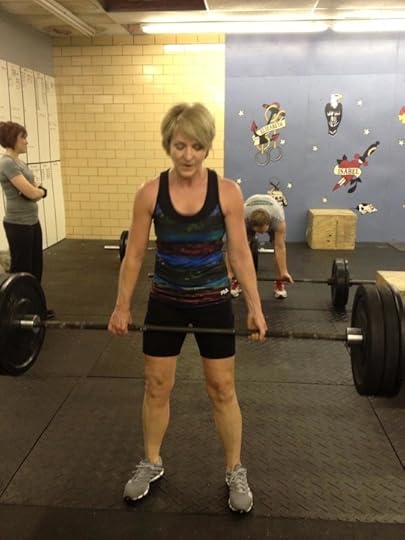
I say that I had adopted the Primal lifestyle, but in reality during the first several months it was mostly the Primal eating style that I embraced. I used to be a twenty-mile-a-week runner, but I had given that up because of back pain, so at this point my exercise consisted of walking. I had the “moving frequently at a slow pace” part down pat, but it took some time to get myself on the rest of the program. That’s where my younger son comes into the picture. Aaron had become a CrossFitter and was often telling me how much I would like it if I tried it. My response was always that I was too old… until October of 2011 when I finally joined in the boot camp program at the gym. In January 2012 my husband and I both jumped into the CrossFit classes, and we’ve been doing 3-4 CrossFit workouts per week ever since. Mark, you are so right about lifting heavy things! It not only has changed my body, but it feels so empowering to be able to back squat my own body weight, lift barbells over my head, climb up a rope or do a bunch of handstand pushups. I consider the short, highly intense workouts that last only a few minutes to be my sprint. While I love the gym atmosphere and the progress I’ve made over my past year in CrossFit, I don’t do CrossFit just so I can do more CrossFit. I do it so I can do whatever I want to do with confidence that my body has the strength and flexibility to handle it. Last summer I went whitewater rafting on the Chatooga River with my two daughters (exactly the section where the movie Deliverance was filmed), and I won my age group in a 5-K race with no real running training. Earlier this month my husband and I went stand-up paddleboarding when we were on a trip to St. Thomas. Who knows what else I’ll try!

Speaking of that trip to St. Thomas, we traveled with people we have known for over 25 years but see infrequently. It was so gratifying to hear their comments about how I look better than ever. My current weight is 128, I wear a size 4 or sometimes a 2, and I do not hesitate to hit the beach wearing a bikini.
My Primal journey hasn’t been about a dramatic weight loss. It has been about some easy-to-do lifestyle changes that I expect to make the next few decades an entirely different life story than they might have otherwise been. That’s why you are on the list of “most important men in my life,” Mark. I’m really glad you came into my life – figuratively speaking, of course.
Kathy
Update:
I wrote to you recently telling you about my two years as a Primal, and I have a quick update.
I allowed my son/trainer to talk me into registering for the CrossFit Open although I felt kind of silly doing it. It was my hope that I could make it through the first workout because I figured it would start with something all body weight and would soon advance beyond my abilities. Well, I did 13.1 on Friday and scored 142. Because I will turn 55 before the Open ends, I was put into the 55-59 Masters Women category, so I got to use lighter weights on the snatches. But here’s the really crazy part. As of right now I am in 17th place in the North Central Region. I still know that I won’t be able to do everything they throw at us in the Open, but I’m having fun with it right now!
Grab a Copy of The Primal Connection: Follow Your Genetic Blueprint to Health and Happiness Today!

April 4, 2013
8 Ways to Cultivate Health Integrity
 In last week’s post “Why Health Integrity Matters,” I suggested that owning your own health journey comes down to willingness – how willing you are to accept full responsibility for each choice you make. I appreciated everyone’s comments and – as always – loved to see how people extended the idea with their own experiences, wisdom, and admissions. Quite a few declared it was a post meant for them and where they were in their personal journey. For various reasons, they needed the reboot, so to speak. I imagine we’re all there at some point – at the skeptical beginnings of major changes, the less than stellar times we lose our footing or the crises of confidence that can settle in when we’re going through a rough patch of life. How do we cultivate health integrity? Let me offer some thoughts – some wholly practical and a couple a little unorthodox. I hope you’ll add your own additions to the list.
In last week’s post “Why Health Integrity Matters,” I suggested that owning your own health journey comes down to willingness – how willing you are to accept full responsibility for each choice you make. I appreciated everyone’s comments and – as always – loved to see how people extended the idea with their own experiences, wisdom, and admissions. Quite a few declared it was a post meant for them and where they were in their personal journey. For various reasons, they needed the reboot, so to speak. I imagine we’re all there at some point – at the skeptical beginnings of major changes, the less than stellar times we lose our footing or the crises of confidence that can settle in when we’re going through a rough patch of life. How do we cultivate health integrity? Let me offer some thoughts – some wholly practical and a couple a little unorthodox. I hope you’ll add your own additions to the list.
Make an excuse board.
Put it all out there – every last whine, reason and justification you use for not living healthily. Make columns for eating crap, chronically skipping exercise (everyone legitimately needs rest days), going to bed late, drinking too much, stressing yourself sick, etc. Every time you use one of those excuses, give yourself a gold star next to it. At the end of the week/month, see how much you’ve excelled at cheating yourself. Harsh, yes, but effective.
Accept your own resistance.
Let’s not gloss over the fact: there are times when we don’t feel like showing up for ourselves. Every one of us probably would pin a different reason on that one, but we’ve all been there. For some, it comes out in our health related choices. For others, it can take a different form (e.g. money, alcohol, etc.). But here’s the rub. We don’t have to like “showing up.” Seriously. You don’t always have to relish making the healthy choice. If you’re generally living well – eating Primally, moving frequently, challenging yourself enjoyably, sleeping soundly, destressing regularly – you know the benefits. Likewise, if you’ve ever backslid – by choice or circumstance – you also know how much you can pay a price. Still, we move through however many moods and challenges each day. Accept that you’re going to be more willing some times than others, but still stick with your basic intention.
Deal with serious underlying issues.
Sometimes there are deep and difficult reasons behind our tendencies toward self-sabotage. Be honest with yourself about the internalized messages and ongoing compulsions that keep weighing you down. Get the help you need to sort it out, and grant yourself permission to believe you’re capable of a better life. Surround yourself with the support and engage in the self care you need to see yourself differently. Accept that it may be a life long commitment and not a single “fix.” While it’s not your fault you were left with the baggage, it’s a choice whether you let it hang around your neck each day.
Plan for your weaknesses.
Keep some Primal worthy snacks at work for the days you have to work late. Put a list of last-minute simple recipes on the fridge for mornings you don’t have time to make what you’d planned. Don’t let the weekend pass without cooking your stash of meat and chopping veggies if you know it means you’re setting yourself up for failure come Monday’s dinner. Keep up on your life enough that you’re not testing yourself unnecessarily. Some things won’t rattle you. Other things will. Be mindful of what will, and be preemptive however you reasonably can.
Accept that you can’t plan for everything.
As good as it is to plan and prepare, it’s important to not make the journey one massive control trip. Loosen up, lighten up, and cultivate enough self-possession that you don’t go nuclear if you forget your lunch one day.
Track your day.
It’s hard to argue with hard numbers. Seeing the concrete rundown of all you’ve done (or not done) in a day can be affirming – or sobering. Either way, you’re facing empirical fact, and that’s a level of accountability itself. There are numerous programs and gadgets you can use to do this: everything from pedometers to sleep monitors, FitDay to the CHRON-O-Meter.
Partner or team up.
It can be easy to skip an open ended group like a run club (not that they aren’t great for other reasons). Skip your team’s basketball match-up with a rival office, however, and you’re gonna hear about it. Likewise, you wouldn’t leave a friend hanging by herself ready for your a.m. run at the park while you hit the snooze for the fourth time.
Write letters to yourself.
I’ve mentioned before an old friend who used to leave notes for himself that aren’t suitable for a general audience. As severe as they were, it was his brand of motivation. I’m not suggesting leaving profanity laced post-its around your home (especially if you have children), but write two letters to yourself and keep them where you can either see them or easily find them. Keep a copy at work or in your inbox. One is to congratulate yourself on taking care of yourself (e.g. “Thank you for not feeding me those awful sugar bomb donuts Phyllis always leaves in the break room. And, by the way, there’s always dog hair on them.). Put a picture of yourself happy and healthy in the letter. For extra emotional tug, put the kids in there, too. Make the other letter a “plead your own case” letter. Make it as imploring, guilt-inspiring, or ruthless as befits your personality. Attach the label of the prescription drug you finally got yourself off of or an old picture you’d rather not remember. If you’re tempted to stay up late for the third night playing Candy Crush on Facebook (No, I do not play this.) or eat the bag of Doritos your brother-in-law left in the cabinet at his last visit, it will be your job to read this letter. You’ll know what you need to say.
So, let me turn this topic over to you. How do you cultivate self-honesty and responsibility in your Primal life? Share your thoughts, reflections, and good humor. Have a great end to the week, everybody.
Grab a Copy of The Primal Connection: Follow Your Genetic Blueprint to Health and Happiness Today!

April 3, 2013
Is It All Just a “Paleofantasy”?
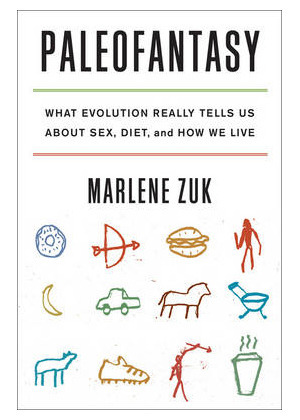 So this is my review of the new book Paleofantasy: What Evolution Really Tells Us About Sex, Diet, and How We Live. It’s been making the rounds for a few weeks now, and although some other people have already weighed in, I’ll add my two cents. At the outset, I’d like to make very clear that I actually agree with a decent portion of Marlene Zuk’s individual arguments. Though it may surprise you to know that Mark Sisson agrees with the most prominent paleo debunker du jour on several topics, I’m not saying I support the overall product or her final conclusions. In fact, Paleofantasy is an odd, meandering book whose ultimate purpose I’m not really sure I truly understand.
So this is my review of the new book Paleofantasy: What Evolution Really Tells Us About Sex, Diet, and How We Live. It’s been making the rounds for a few weeks now, and although some other people have already weighed in, I’ll add my two cents. At the outset, I’d like to make very clear that I actually agree with a decent portion of Marlene Zuk’s individual arguments. Though it may surprise you to know that Mark Sisson agrees with the most prominent paleo debunker du jour on several topics, I’m not saying I support the overall product or her final conclusions. In fact, Paleofantasy is an odd, meandering book whose ultimate purpose I’m not really sure I truly understand.
There are two main problems with the book, as I see it. First, she’s working against a straw man. Many of the arguments she debunks, like “eyeglasses aren’t paleo” or “the paleo diet was carnivorous,” seems to have been dug up from some random Internet commenter or drawn from fringe camps. In other words, they aren’t arguments people like Robb Wolf, Chris Kresser, Paul Jaminet, or me (or our readers) are making. Second, many of her counterarguments or “nuanced approaches” are the very same ones we’ve been exploring at length for years! After reading the book, John Durant tweeted “Paleofantasy shouldn’t have been a book in 2013, it should have been a blog post in 2010,” and that’s as good a description as I can think of.
It’s all very uncontroversial:
There is no one paleo diet.
Who’s saying that? Humans have spanned the globe for millennia, surviving and even thriving in environments ranging from tropical to temperate, from arctic to near-aquatic, all the while subsisting on the wild foods available to those regions. Same basic diet of animals and plants, different configurations.
Evolution doesn’t just stop and humans didn’t just reach a state of perfect adaptation back before agriculture from which we’ve never progressed.
Sure. I talked about how we’re still “evolving” last year, even mentioning Zuk’s favorite topics – lactase persistence (35% worldwide, which is far from 100%) and amylase production. She discusses a few more recent changes, like malaria resistance, adaptation to high altitude, and earwax differentiation, but that’s it. If she wanted to, I’m sure she “could keep adding to the list” and mount an overwhelming case for widespread genetic adaptations to grain consumption, chronic stress tolerance, and sedentary living, but she’s saving up material for the next book. Or something. Either way, I’m not very convinced by her “list” of rapid evolutionary changes, especially considering most of them have little to do with the mismatches we discuss in this community and none of them are even present in a majority of humans.
Zuk is also quick to misrepresent “our” arguments so she can swoop in and take the sensible position – positions the ancestral health community has long occupied!
In her exercise chapter, she characterizes paleo exercise proscriptions as “short and intense” and “literal-minded,” mimicking activities like “having to run down a rabbit for dinner.” We type away at our computers on caveman forums, spend a little while lifting weights and running sprints, and sit back down. Then, Zuk explains that contrary to our reenactment fantasies, the real problem and the real divergence from our past is that modern humans sit too often. It is our inactivity, our hours and hours spent doing nothing physical that hurt us. What we should be doing is lots of slow moving, steady low-level activity like walking, hiking, gardening, yard work, house work, rather than sitting all day and trying to make up for it with a hard gym session. Hmm - where have I heard that kind of stuff before? Why hasn’t the ancestral health community addressed this pernicious force in our lives?
Later, she rightly claims that paleo authors are suspicious of endurance training, mocking my position that the idea that “natural selection redesigned our simian shapes to run the Boston Marathon is… ludicrous.” As support for her claims, she cites Louis Liebenberg’s persistence hunting studies (PDF) with the Kalahari bushmen of Botswana where men would go on hunts lasting “two to five hours, with an average running speed of 6.3 kilometers (about 4 miles) per hour.” Those are fifteen minute miles. If you were running the Boston Marathon at a 15 minute-mile pace, you’d finish in six and a half hours (roughly). That’s an easy run (fast walk?), especially for someone who’s reasonably fit. You could hold a conversation at that speed. You could get up and do it again the next day at that pace. That’s not chronic cardio. That’s not a competitive time for an endurance athlete – the dogged pursuit of which is precisely what I’ve always warned against. It’s easy aerobic activity, the kind I promote!
Even when she acknowledges the potential utility of an evolutionary approach to analyzing health or current environmental “mismatches,” they are glossed over or relegated to a single sentence buried in a paragraph. Zuk spends an entire chapter explaining how traditional child-rearing, with its extended family members available for childcare, extended breastfeeding, co-sleeping, baby-wearing, parental “indulgence” of crying babies, is likely the biological and evolutionary norm for human infants, citing Dr. James McKenna’s extensive research on the benefits of the aforementioned methods… and then ends the chapter by saying “most children grow up fine” so let’s not bother with it. Let’s just keep on keepin’ on.
In response to the idea that limiting artificial light at night and getting plenty of natural light during the day might improve sleep and preserve our circadian rhythms, she asks “is this really the solution to our health problems?” She creates an argument that we are all apparently positing – that smashing light bulbs and waking up at dawn are the cure to all our health problems – and then proceeds to dismiss it, to laugh it off. And yeah, it’s ridiculous to say that unnatural light is the cause of all our health ills… but who’s saying that? Who’s making this argument but her? And on that note, what about the negative effects of artificial light at night? Aren’t they worth investigating? Isn’t the data we already have fairly compelling?
(If you notice me asking a lot of questions in apparent exasperation, it’s because I’m puzzled and exasperated and driven to inquiry by some of these “arguments.” Forgive me.)
A worrisome theme starts to emerge: that the past is murky and we need more data so let’s not make any sudden changes to the way we live, especially not if they’re couched in evolution. I disagree. Whatever most people are doing isn’t really working for most people, whereas whatever we’re doing (whether it’s a paleofantasy or not) seems to be working.
To her credit, Zuk doesn’t throw out the idea of evolutionary mismatch altogether (although you could have fooled me). She just rails against “denouncing modern living as unsuitable to our Stone Age genes,” calling for research into “just what parts of that life send us too far out of our evolutionary zone of tolerance,” as if she’s stumbled upon some revolutionary concept. Really, though, we are exploring and identifying the specific aspects of modern life that trigger a mismatch. We are gathering data. Academics and scientists and bloggers and lay individuals are figuring out, in fits and starts and lurches and self-experiments and clinical trials and study analyses, just what works about modern life and what does not work. We’re not resting on our laurels, on our assumptions.
So we kind of agree, even though it appears she doesn’t know it.
I don’t necessarily blame Marlene Zuk for her failure to comb the ancestral health community’s tomes, read all the blogs, study the comment sections (although she seems to have a fondness for anonymous blog commenters), attend the symposiums and conferences (although much of the material is available online for free), and explore the message boards. There’s a lot of material to cover. It’d probably take years to really do a thorough job. But if she hoped to publish a relevant critique of the community, she probably should have understood its actual claims instead of erecting a straw man for easy defeat.
In John Hawks’ favorable review of the book, he says that we must “play with hypotheses, explore their predictions and try very hard to falsify them.”
I completely agree. I think Zuk agrees, too, and I think I may have divined her ultimate goal with this book. In her 2009 NY Times piece on the same subject, she said “we shouldn’t flagellate ourselves for having modern bodies, and we shouldn’t assume that tweaking our diets or our posture will rescue us from all our current ills.” She thinks people are rushing headlong into such dangerous lifestyle changes as giving up grains, sugar, and seed oils without doing their due diligence.
You’ll have no arguments from me. Assume nothing, test/tweak/research everything. It’s not like I’m sitting here typing away, conjuring up fantastical stories about the past and making big lifestyle proscriptions based on said stories. Those success stories are actual success stories from actual people. Those studies cited are actual studies from real journals. I suppose you could make the argument that all these folks losing weight and gaining muscle and getting off meds and regaining their lives after adopting a Primal way of eating, living, and moving cannot definitively establish the lifestyle was the precipitating factor. They can’t “prove” it works. It could all be a big dream.
A big paleofantasy. I could be making this entire world up in my head as I go along, a lonely brain in some amniotic sac with electrodes attached, my entire history and the blog and the books and my relationships all constructs of my mind. I don’t think I am, though. I think this is real, flesh-and-blood stuff.
Are improved blood sugars, better blood lipids, a hundred pounds of weight loss, newly emergent abs, steady midday energy, improvement of autoimmune disease, and new leases on life paleofantasies? No.
Are sitting in front of an LCD screen until 2 AM, spending zero time in nature, living off of Cheetos and Coke, walking under a thousand steps a day, and working 20 hour days at a miserable job evolutionary mismatches with drastic health consequences as shown by current science (and hinted at by anthropology)? Yes.
And that’s what it comes down to in the end: results. We got ‘em, and people recognize that.
Have you read Paleofantasy? What do you think? Let everyone know in the comment board, and thanks for reading!
Grab a copy of Primal Blueprint Quick & Easy Meals for over 100 Primal Recipes You Can Prepare in 30 Minutes or Less

April 2, 2013
How to Use the Friday Success Stories to Grok On and Keep Evolving
 This is a guest post from Susan Alexander of app4Mind.com.
This is a guest post from Susan Alexander of app4Mind.com.
I study behavior modification like Mark studies nutrition, movement, and lifestyle. He’s created a paradigm of related principles for Primal living, as I’ve created a paradigm for self-chosen life change. Our similar interests, along with the fact that I’m a longtime member of the MDA community, is how I’ve come to write this post. Reading the Success Stories every Friday for as long as Mark’s been posting them, I’ve figured something out. There are common threads running through these stories that explain why so many different kinds of people, in so many different circumstances and walks of life, have been able to transform themselves through the PB.
This post is about those common threads. They happen to be the essential behavioral principles that enable us to make a substantial life change and sustain it – which is what we’re all endeavoring to do here in becoming and being Primal. None of us has it completely nailed. The point of the PB is to keep evolving. The point of this post is to help everyone do just that. So let’s get started, shall we? Here are the common threads:
Evolutionary belief
The Success Story writers share the basic core belief that they can evolve themselves throughout their lives. In other words, they believe this basic idea: “The way I am now is not the way I always have to be.” This belief is known as the growth mindset, identified and studied over a 20 year period by Stanford psychologist Carol Dweck.
 Mindset is reflected in what people do – as we see over and over again in the Success Stories. People who think they can evolve themselves do evolve themselves. We see a wide array of approaches to getting started, all of which worked. See e.g. Ed & Amy (“it struck a beautiful chord with us …. we tossed everything in the house”); Michael (“After reading MDA for a day I decided to abandon the vegetarian path entirely and take the plunge into the Primal lifestyle”); Katie (“I wasn’t totally convinced of the fat thing right away …. over the course of a year I made small changes”); Myra (“I decided to give this Primal thing a try for a week.”); Lee (“Without a lot of thought or effort, I transitioned into it.”); Adina (“I spent the next few months reconsidering why I’d become vegan.”).
Mindset is reflected in what people do – as we see over and over again in the Success Stories. People who think they can evolve themselves do evolve themselves. We see a wide array of approaches to getting started, all of which worked. See e.g. Ed & Amy (“it struck a beautiful chord with us …. we tossed everything in the house”); Michael (“After reading MDA for a day I decided to abandon the vegetarian path entirely and take the plunge into the Primal lifestyle”); Katie (“I wasn’t totally convinced of the fat thing right away …. over the course of a year I made small changes”); Myra (“I decided to give this Primal thing a try for a week.”); Lee (“Without a lot of thought or effort, I transitioned into it.”); Adina (“I spent the next few months reconsidering why I’d become vegan.”).
The opposite of the growth mindset is the fixed mindset. As Primal followers, we hear it all the time in people who say things like: “I could never do that;” “I don’t have the genes for that kind of body;” “The treadmill is fine for me.” The bottom line is this: fixed mindset people don’t think they can change very much. They think their skills, aptitudes, and temperament are fixed, so they themselves are fixed. That’s why they’re not open to change.
Not everyone in the non-Primal world has a fixed mindset. There are plenty of growth mindset people out there who just haven’t heard of the PB or decided to try it yet. As for the fixed mindset people out there, there’s hope. Switching from a fixed mindset to a growth mindset is easier than you might think. Just knowing about the two mindsets enables you to spot the thoughts that go with each one. You’ll start catching yourself in fixed mode, and from there, you can consciously switch into growth mode. After a while, it won’t take so much conscious effort. The growth mindset just becomes yours.
Takeaway #1: The growth mindset is, by its nature, evolutionary. It’s the simple belief that we can change and grow throughout life, through our own efforts. This belief is a major common thread running through the Success Stories. Its opposite is the fixed mindset belief that the way we are now is the way we always have to be. If you’re on the fence about going Primal, or you’re already Primal but you’re feeling stuck, there may be some fixed mindset thoughts going on in your head that are holding you back. Work on a mindset switch first. Read some success stories – it’s a great way to get some growth mindset optimism. Then try something new or different from what you’re doing now.
Evolutionary action
Another common thread running through the Success Stories is evolutionary action. We see all the writers evolving their efforts (and themselves) over time, in a continuous, iterative way. They all see the Primal Blueprint as exactly what it is – a continuing, lifelong process (as opposed to a “diet,” a quick fix, or something they’re doing just for now). See e.g. Mike (“My idea of fun is bettering myself and continuing to learn”); Myra (“My Primal journey continues as I try out different things and continue to learn how my body wants me to live.”); Jeffrey (“This has become much more than a way to lose weight for me, it is ingrained into who I am”); Katie (“I’m still learning and tweaking every day”); Jesse & Vickie (“We knew we wouldn’t be ripped in just 21 days”).
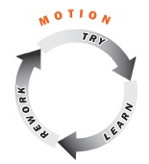 This continuous, iterative approach to Primal is reflective of what I call the motion loop – which is simply my illustrated distillation of the classic trial and error process through which all species in the universe evolved. When it comes to evolving ourselves throughout life, we follow the same course. To find what works for us – in all that we do – we do as the arrows say: we try things out, we learn from the results of our efforts, and rework what we’ve done. Then we try out our rework, learn from that, and rework again. To keep evolving our efforts and ourselves, we keep looping, over and over, just like this.
This continuous, iterative approach to Primal is reflective of what I call the motion loop – which is simply my illustrated distillation of the classic trial and error process through which all species in the universe evolved. When it comes to evolving ourselves throughout life, we follow the same course. To find what works for us – in all that we do – we do as the arrows say: we try things out, we learn from the results of our efforts, and rework what we’ve done. Then we try out our rework, learn from that, and rework again. To keep evolving our efforts and ourselves, we keep looping, over and over, just like this.
We see in the Success Stories that the motion loop is not a theory. It’s how effective people work in real life. We see each of the writers embracing the PB over time in just this way, without the objective of getting “done.” See e.g. Sean (“The Primal life is not a diet to me and has no ultimate finish line”); Dave (“Learning is something I will do forever and this way is a great place to learn … to live … to experiment and find your space that works for you”).
Takeaway #2: The motion loop reflects the classic trial and error process by which all species in the universe evolved. On an individual level, it’s our means of self-evolution. By staying in the motion loop with whatever we’re doing, whether it’s the PB or something else, we keep evolving our efforts and ourselves.
Evolutionary feedback
Evolution is chaos with feedback. – Joe Ford
The next common thread running through the Success Stories is the reliance on feedback. All the writers rely on it to keep their Primal journeys evolving. As we’ve already seen, feedback is an integral part of the motion loop. It’s precisely what the writers look to (and all of us must look to ) in order learn from our efforts and keep the motion loop going.
There are two main kinds of feedback running through the Success Stories: feeling and tracking. Let’s look at both.
Feeling
Every single story details the feelings that arose from going Primal. The writers recount a wide range of physical to emotional feelings, with a lot of overlap. See e.g. Heath (“I now feel that I have a new lease on life”); J.P. (“I started to become more patient with people … and overall felt better emotionally. I literally was becoming happier”); Nikki (“I feel like I’m living my life the way I should be”); Cynthia & Paul (“feeling super fit and healthy all while training less and being true to our Primal selves”).
Feelings are a crucial source of feedback in any change we make, whether it’s going Primal, trying something new in our Primal journey, or some other change. Why are feelings so crucial? Because how something makes us feel has everything to do with whether we keep doing it. Decades of research by preeminent psychologist Mihalyi Csikszentmihalyi explains why. His work can be distilled into this simple idea: Extrinsic motivation may be present somewhere in the background, but it’s rarely the main reason we do what we do. We humans like the feeling of evolving ourselves – by building skills, overcoming challenges, and being part of a process that leads to a higher level of harmony in life – so when we find something that gives us this feeling, and it’s learnable and accessible to us, we keep doing it.
Another way to view evolution is to see it not as the selective survival of life forms such as dinosaurs or elephants, but of information. Inside each person there is a wonderful capacity to reflect on the information that the various sense organs register, and to direct and control these experiences …. [H]aving a self-reflective consciousness allows us to write our own programs for action, and make decisions for which no genetic instructions existed before. – Mihalyi Csikszentmihalyi
The PB is precisely that something, for everyone who’s written a Success Story and for the whole MDA community. There are lots of specific reasons we all can list for being Primal, but in its simplest terms, what’s really going on is this: We do it because we like it. We like it because it feels good. Self-evolution is inherently likable.
If you’ve been skimming this post, this is a good time to start reading every word, because what I’m about to tell you will change your life.
There is a particular feeling that shows up again and again in the Success Stories that’s not well understood but very powerful. Acclaimed author and psychiatrist Edward Hallowell calls it mastery. I’ve renamed it slightly. I call it micro-mastery to differentiate it from what we normally think of when we hear the word mastery.
Micro-mastery isn’t full mastery, as in the way Picasso mastered art or Wayne Gretzky mastered hockey. It’s something completely different. As Dr. Hallowell explains, it is not an accomplishment or the reaching of a goal. Instead, it’s that simple feeling of “Now I get it!” or “I can do it!” that comes when you’ve been trying hard to do something, and you do a small part of it just well enough to give you that feeling.
That’s it. That’s all micro-mastery is – a feeling. It seems small, but it’s huge. Because we humans like that feeling. So when we feel it, we’ll work to feel it again and again. When we’ll work to feel something, it means we’re intrinsically motivated. Thus, micro-mastery is a source of intrinsic motivation we make ourselves, through our own actions.
The Success Stories are a beautiful treasure trove of written accounts of self-made motivation brought on by micro-mastery. Over and over, we see writers come right out and say, unequivocally, that when they felt one part of the PB working, even just a little bit, it motivated them to go farther in their Primal journeys. Great examples are Andy, Keri, and Jenna:
Andy saw his weight drop a bit in each of his first 3 weeks of going Primal. “Talk about motivation!” he wrote. By his own account, it’s precisely what lead to his gradual, linear pursuit of athletic goals (a 5k, a 10K, and a 1/2 marathon).
Keri found herself where a lot of women runners do: gaining weight while training. Stumbling on MDA lead her to shift her macronutrient balance (to more protein and fat and fewer carbs). From that, she felt herself transform from a sugar burner into a fat burner, and she loved the feeling. Finding she could train on fewer carbs and have great race results, her motivation shifted as well. It became more intrinsic and less extrinsic. Here are her exact words: “I am not sure where my running will take me in the future but I know that the motivation will be from the pure enjoyment of getting outside every morning … not the calories burned.”
Jenna felt her breathing improve and her weight drop a little. That motivated her to start exercising – and she soon started liking the feeling of exercise, so she didn’t have to make herself do it anymore. She did it because she wanted to. She wrote: “There are so many gifts I have gotten from following the PB. My health, my motivation, my identity …. I am getting stronger, and exercising more because I enjoy it now, not because it’s a chore.”
Takeaway #3: Feedback from feelings fuels the the Primal process, because how something makes us feel has everything to do with whether we keep doing it. As we see in the Success Stories, many different kinds of feelings serve as valuable feedback. One of those feelings is micro-mastery. It’s important because it’s a source of intrinsic motivation. Once we feel micro-mastery, we’re on our way to being intrinsically motivated, because we like the feeling so much that we want to feel it again and again. Thus, it’s not true that we have to be motivated first, before we get started making a change in our lives. We can get started even when we don’t want to, and even when we think we’re not “ready.” Because motivation kicks in during the process. We create it ourselves by reaching micro-mastery, over and over in the motion loop.
Tracking
Tracking is another common thread running through the Success Stories. By tracking, I mean that the writers used metrics of some kind to gauge what works and what doesn’t. Their metrics reflected their reasons for going Primal. For example, PaleoBird and Andrew went Primal to lose weight (among other reasons). Through self-experimentation, they both found that carb reduction alone wasn’t effective, so they both restricted calories as well. So their metrics and tracking focused on those things in the weight loss part of their efforts.
While weight loss is a common reason for going Primal, it’s not the only reason. The Success Stories make this clear. The writers had many other concerns, and they chose the PB, at least in part, as a means to healing themselves in some way or addressing medical conditions. As such, their metrics reflected those things. Katie created pie charts of the foods she was eating to get at the cause of her migraines (among other reasons). Michael kept medical stats relating to an array of health concerns.
It does seem that a few writers geeked out over going Primal for the pure enjoyment of geeking out, and that’s a great thing. It got them into the flow of their Primal Journeys and kept them focused. See e.g. Shane (charted his entire first year of being Primal); Jason (tracked weight, carb count, and blood work in his transformation from sugar burner to fat burner). There’s much to learn from their efforts, so be sure to have a look.
Tracking doesn’t have to to be elaborate, and it doesn’t even have to include numbers. You can keep a simple journal and write whatever is meaningful and helpful to you.
Takeaway #4: Tracking is a powerful source of feedback. There are as many ways to track as there are people tracking. The idea is to track what’s important to you in a way that makes sense for you and the change you’re making. The same is true for metrics. It’s where we get our much-needed answers to these fundamental questions: What are the effects of what I’m trying? What’s working? What isn’t? What’s next? Should I keep doing what I’m doing, or tweak and adjust it, or change courses entirely? It’s getting to these answers that propels us through the Motion loop of change, i.e. that powerful, continuing circle of try, learn, rework, that keeps us evolving.
Summing it all up
The common threads running through the Success Stories comprise the essential behavioral principles that enable us to make a substantial life change and sustain it. That’s what we’re all trying to do here, in becoming and being Primal. Knowing what these essential principles are, and seeing how so many people have put them into action, will help you evolve all your Primal endeavors and any other change or self-evolution you have in mind.
For those interested, I’ve taken these essential principles of change and created a “mind app” out of them. It’s called app4Mind. You’re all welcome to use it to change your life and Grok on!
Order Your Copy of The Primal Blueprint 90-Day Journal Today to Grok On and Keep Evolving

April 1, 2013
Dear Mark: Eggs, More Eggs, and Marathon Man
 For today’s edition of Dear Mark, we’re talking eggs, eggs, and marathons. First up are egg allergies/intolerances as determined by blood test. It’s not exactly clear what blood test was used to determine the inflammatory response to eggs, but regardless: the test was done and the reader is now worried about eggs, previously one of her favorite foods. Can she reintroduce eggs? Should she even worry at all? Next are eggs and blood lipids. Our reader’s naturopath has warned against four times daily egg consumption because of elevated LDL, and she wants to know if there’s really any reason to follow the advice. I lay out some of the evidence in favor of egg consumption; hopefully it’s enough to satisfy. Finally, I discuss the curious case of Stefaan Engels, the man who ran 365 marathons in 365 days. Does he discredit my whole view of fitness, chronic cardio, and endurance training? Should you therefore take up daily marathoning? Read on to find out.
For today’s edition of Dear Mark, we’re talking eggs, eggs, and marathons. First up are egg allergies/intolerances as determined by blood test. It’s not exactly clear what blood test was used to determine the inflammatory response to eggs, but regardless: the test was done and the reader is now worried about eggs, previously one of her favorite foods. Can she reintroduce eggs? Should she even worry at all? Next are eggs and blood lipids. Our reader’s naturopath has warned against four times daily egg consumption because of elevated LDL, and she wants to know if there’s really any reason to follow the advice. I lay out some of the evidence in favor of egg consumption; hopefully it’s enough to satisfy. Finally, I discuss the curious case of Stefaan Engels, the man who ran 365 marathons in 365 days. Does he discredit my whole view of fitness, chronic cardio, and endurance training? Should you therefore take up daily marathoning? Read on to find out.
Let’s go:
I had blood work done that showed eggs, and especially egg whites, were the number one food allergy causing inflammation in me. Eggs are one of my very favorite foods and because of the tests I have all but eliminated them from my diet. Is it possible that eggs can be reintroduced into my diet after some time on the primal blueprint?
Thank you for any suggestions!
Gayle
I’d be interested to hear exactly what this blood work consisted of, because if it was IgG allergy testing, I’m not very convinced. Egg allergy is one thing, where you have a bite of food containing eggs and end up going into anaphylactic shock. That’s bad, that’s dangerous, and you can’t really ignore it. If eggs are an imminent threat to your life and you feel awful eating them, by all means, listen to the blood work and eliminate the eggs. The simple fact that they are one of your favorite foods, however, makes me think that eggs aren’t having a noticeable impact on your health.
If it was an IgG allergy test, there are serious doubts as to its accuracy and usefulness in identifying allergies or sensitivities. Chris Kresser, in one post, recounts how he once received back completely different results after sending two vials of his blood to the same lab for testing. And one study even found that every subject tested positive for ovalbumin-specific (egg white) IgG levels, whether they had active egg allergies, resolved egg allergies, or were completely free of egg allergies. The authors suspect that “strong IgG responses to OVA may be a normal physiological response to a protein frequently ingested from infancy.” Another study found that children who had higher IgG responses to egg protein as infants actually showed greater tolerance of egg protein later in life. If everyone has positive responses to egg-specific IgG levels regardless of allergic status, what’s the point of testing? And if higher IgG responses to proteins have even been shown to indicate greater tolerance of said proteins, are IgG tests really useful in determining intolerances?
How did they determine that they’re causing inflammation in your body? Did you get a C-reactive protein test? Did they test for specific inflammatory cytokines? Or do you get symptoms of inflammation upon egg consumption – achy joints, irritated skin, gastrointestinal upset? Or is the “inflammation” an abstract thing purely represented by numbers on a lab test? A blood test is rarely sufficient, particularly absent subjective symptoms.
You may very well be sensitive to eggs. Many people are. But most people who are sensitive to eggs don’t consider them a favorite food. You could be suffering from inconspicuous inflammation, doing damage to yourself without really knowing it. But in the absence of obvious symptoms, I’d hesitate to banish eggs entirely from your diet. Eggs are nearly unparalleled in the nutrition realm. They’re an excellent source of highly assimilable protein and vitamins like A, choline, K2, and folate, and they can be a good source of omega-3s if the hen’s diet is right. Take them out for a few weeks to see how you react, sure. Nothing wrong with an elimination diet. That way, you’ll get actual answers in about 30 days, and you’ll be able to determine whether or not eggs are causing problems.
Look into your intestinal permeability, too. Oftentimes errant food proteins worm their way into our blood stream by way of an overly permeable intestinal wall, thereby prompting an immune response. Eat more gelatin and bone broth, consider probiotics, and eat some fermentable fiber to improve your gut health.
One final note: if it’s egg white you’re worried about and sensitive to, just eat the yolks. The yolks are the best part, anyway. If you trust your eggs, there’s no better multivitamin than a few raw pastured egg yolks in the morning.
I am seeing a naturopath and she is a bit worried about my LDL cholesterol, and is concerned I am eating too many eggs (3-4 for breakfast every day and the odd extra one with dinner). She says she normally doesn’t worry about eggs but in my case maybe it’s time to pull it back a bit….but hang on, everything I have read in paleo-land tells me that eggs are fine.
She said another comment that intruiged me, that because I fry my eggs (in coconut oil) or make an omelette that the yolk is exposed to air and they oxidise, and this may be the problem. She recommended cutting back to 2 eggs a day and only poaching under water or boiling. Have you ever heard such a thing and could it have any credence…or is it time to find a new naturopath!
I am one of your many readers from Australia and send you a big thanks for the work you do from Down Under.
Simone
The vast majority of the evidence shows that egg consumption has either no effect or a favorable effect on serum lipids, particularly if you’re eating low-carb/high-protein (terms which are usually synonymous in the medical literature):
As part of a high-protein diet, egg consumption improves blood lipid and blood glucose profiles in type 2 diabetics.
Heck, if you’re eating low-carb, eggs might actually make it work even better than a low-carb diet without eggs, probably due to the cholesterol increasing HDL and improving antioxidant function. Or, it might be the increase in HDL and LDL particle size (and probable reduction in HDL and LDL particle number) along with the higher levels of circulating antioxidants doing the trick. Or both. Either way, eggs fit quite nicely into a Primal eating plan.
Of course, you could be a rare poor responder to eggs. Some people experience increases in cholesterol (although it’s usually both HDL and LDL, so it ends up a wash in a sense). It probably won’t hurt to spend a few weeks at a lower daily egg intake just to see what happens to your lipids. They might drop. You might feel even better than before. They could also drop, and you end up feeling worse. After all, cholesterol is converted into important hormones like pregnenolone and testosterone and vital prohormones like vitamin D. Lipoproteins also deliver nutrients (beyond just cholesterol) to cells. Lower cholesterol – even LDL – isn’t always better. Don’t ignore subjective measurements of health, like energy levels, libido, workout performance, and general feelings of awesomeness.
Oxidized cholesterol from overcooked eggs might be able to increase the portion of oxidized cholesterol in your LDL particles, but I haven’t seen any evidence that it would increase circulating levels of LDL. It’s just that the LDL in your LDL particles might be a bit more oxidized and therefore prone to trigger atherosclerosis. Overall, I think the fear of oxidized cholesterol because you cooked up an omelet is overblown. High-heat, high-pressure spray drying of eggs? Yeah, that’ll oxidize the cholesterol. Cooking them up in coconut oil? Scrambling and subjecting them to a hot buttered pan for a couple minutes? I don’t think you have much to worry about.
That said, I am quite partial to soft boiled eggs. I just pop three or four in my pressure cooker with a cup of water, set it to steam for three minutes, and immediately immerse them in cold water. The white comes out soft, smooth, and fully-cooked while the yolk remains warm and runny. I mostly do it because it’s easy (I can just set the timer and walk away) and tasty (a runny yolk is paramount), but I can see it being “healthier” in that it eliminates any chance of cholesterol oxidation (not that I think we need to worry too much).
How do you explain Stefaan Engels? He ran a marathon everyday for a year, ate whatever he wanted, and showed no muscle or cartilage damage.
Keerthana
Engels is certainly impressive, but he’s pretty easy to explain.
He’s an outlier, well-suited for marathon running. I’ve never argued that you can’t run marathons and be healthy. I’ve merely argued that running and (most importantly) training for marathons at an elite level usually means avoiding other beneficial ways to train, and results in aches, pains, and injuries. Just because lots of slow moving, some sprinting, and heavy lifting (and even some endurance work alongside) builds more lean mass and more well-rounded fitness in a fraction of the time doesn’t mean marathoning means certain death.
Not to take anything away, but it was a parlor trick. He took an average of four hours to complete each marathon, which means he was taking a little over nine minutes per mile. For him, an elite endurance athlete (and accomplished triathlete), he probably never got past 60% of his max heart rate, which might not even qualify as chronic cardio in his case. A 9+ minute/mile pace is far better than most people could do, but it’s not very hard for him. He was taking it relatively easy. Engels’ best time was 2:56, and 4:00 is an easy jog for a guy with a sub 3:00 marathon.
As for eating whatever he wanted, exactly! When you’re training for marathons like I was, you have to be willing to shovel just about anything in, purely for the easy and quick calories. Superhuman levels of athletics often require superhuman levels of consumption – just look at Michael Phelps.
Nothing against Engels or his feats, mind you. But his situation really isn’t applicable to the average Joe, for whom I write my books and my blogs.
There were runners in the 1970s who regularly did 250 training miles a week and then raced hard and fast. My friend Dave McGillivray ran across the USA (3,452 miles) in 80 days. He turned out fine, but most of the other guys are dead or ailing now. Many of my triathlon buds had no signs of damage during their careers, but years later had big problems.
So yeah, you can do it, but it doesn’t mean you should.
That’s it for this week, guys. Thanks for reading and be sure to leave a comment!
Grab a Copy of The Primal Connection: Follow Your Genetic Blueprint to Health and Happiness Today!

March 31, 2013
Weekend Link Love
 Last-minute tickets for PrimalCon Oxnard 2013 (April 11-14) are now available due to some cancellations. Space is limited. Order your tickets today before spots run out!
Last-minute tickets for PrimalCon Oxnard 2013 (April 11-14) are now available due to some cancellations. Space is limited. Order your tickets today before spots run out!
Tickets for PrimalCon Austin 2013 are also available. Join us June 6-9 for an event you’ll never forget.
Thank you for sharing your excitement for upcoming Primal Blueprint books and your ideas for new titles last week. The randomly selected winner of the prize package giveaway is Susy Fry.
Research of the Week
Transfer of “lean” gut flora into the sterile guts of obese mice triggered rapid fat loss in a recent study.
They were far from human subjects, but fruit flies fed an organic diet enjoyed better health outcomes than fruit flies fed a non-organic diet.
Interesting Blog Posts
How one Primal kid fought back against MyPlate and came up with his own – far superior, in my opinion – version.
Seth Roberts recently explored earwax transplantations.
Media, Schmedia
Logan LaPlante knows what he wants to be when he grows up: happy. What about you?
Gwyneth Paltrow may get a lot of flak for deciding not to feed her kids empty carbs, but not everyone agrees with the criticism.
Everything Else
“No one can fully digest gluten,” said the Mayo Clinic doc.
Our ability to truly connect with other human beings is a physiological entity that must be trained and maintained or else wither into dystrophy, like muscle. Does excessive smartphone usage trigger empathy detraining?
Recipe Corner
Leafy greens are one thing conventional health advice gets right, and sometimes we need a reminder. Here’s a nice, simple, delicious recipe for German-style simmered spinach.
Zucchini waffle sandwiches.
Time Capsule
One year ago (Mar 31 – Apr 6)
Is Eating Meat Ethical? – My entry for the infamous NY Times essay contest on ethical meat eating.
Why Fast? Part Four – Brain Health – How skipping breakfast can impact your neurological function for the better.
Comment of the Week
This post is starting to sound like some bizarre game of foodie one-upmanship:
“The most exotic thing I’VE ever had was manatee muzzle sauteed in badger bile!”
“Oh, is that anything like camel colon smothered in snake snot?”
- For what it’s worth, camel colon is high in butyrate and snake snot is a rich source of DHA.
Get All Three Primal Cookbooks, an Apron and More in The Primal Blueprint Chef Kit Today!

March 30, 2013
Chinese Five Spice Pork Chops with Sautéed Escarole
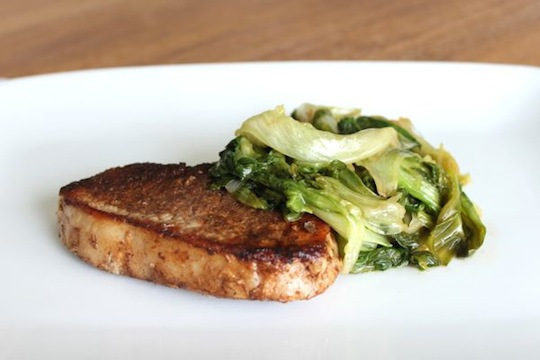 Escarole is mostly thought of as a salad green, but like most greens, it’s capable of so much more than that. In this recipe, a hint of vinegar, a pat of butter and a scant drizzle of maple syrup turn escarole into a warm side dish that’s perfect with pork. It’s a bold medley of sweet, salty and pleasantly bitter flavors.
Escarole is mostly thought of as a salad green, but like most greens, it’s capable of so much more than that. In this recipe, a hint of vinegar, a pat of butter and a scant drizzle of maple syrup turn escarole into a warm side dish that’s perfect with pork. It’s a bold medley of sweet, salty and pleasantly bitter flavors.
The bitter flavor of escarole can be a “love it” or “hate it” thing. This recipe is meant to woo both sides. The bitterness is still noticeable, but tamed by a magic combination of pork, butter and maple.
The chops are seasoned with Chinese Five Spice, giving the pork both a little heat and the sweet aromatic flavor of cinnamon, cloves and fennel. The butter and maple syrup further balance out the bitter flavor of the escarole, but you don’t have to add maple syrup to make this dish great. Skip it, and you’ll still have a delicious meal with bold flavor.
A very large head of escarole wilts down to four small servings when cooked. Plan to serve another side with the meal, or, if you really love escarole, cook two heads instead of one.
Serves: 4
Time in the Kitchen: 35 minutes
Ingredients:
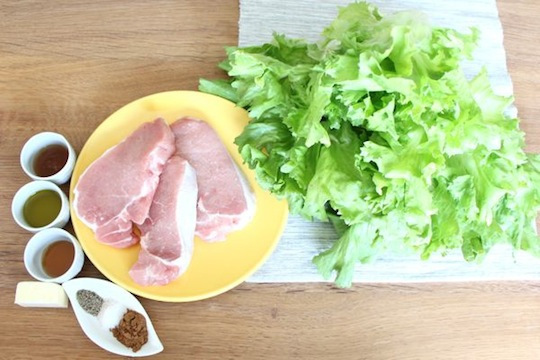
4 pork chops, about 1-inch thick (2.5 cm)
1 teaspoon Chinese five spice (5 ml)
1/2 teaspoon salt (2.5 ml)
1/4 teaspoon black pepper (1.25 ml)
1 tablespoon olive oil (15 ml)
1 large head of escarole (about 1 pound)
1 tablespoon apple cider vinegar (15 ml)
1 teaspoon maple syrup (5ml)
2 tablespoons butter (30 ml)
Sea salt
Instructions:
Preheat the oven to 350 ºF (176 ºC).
Take the pork chops out of the refrigerator so they come to room temperature. Season both sides of the pork chops with Chinese Five Spice, salt and black pepper.
Cut the bottom stem off the escarole and wash the leaves well since they tend to hold dirt.
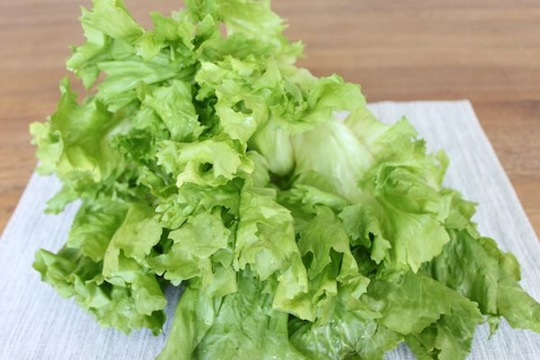
Before or after washing the leaves, tear them into bite-sized pieces. Ideally the leaves should be as dry as possible before cooking them. A salad spinner works well for this.
Heat a large ovenproof skillet over medium-high heat and add olive oil (or coconut oil, or a combination of olive oil and butter). When the oil is nice and hot add the chops, searing for 3 minutes without moving them. Flip the chops and sear for 1 minute more then put the pan in the oven.
Start checking the chops after 3 minutes to gauge if they’re done. The temperature in the thickest part of the chop should be around 140 ºF. (60 ºC).
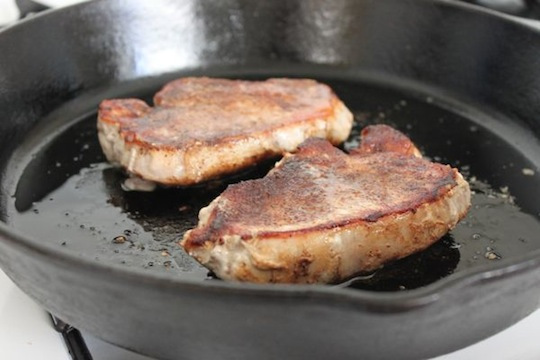
Remove the chops from the skillet and set the meat aside. Put the skillet back on the stove over medium-high heat and immediately add the vinegar.
As it boils scrape the bits of meat up off the bottom of the skillet. The vinegar will quickly evaporate – when it’s evaporated by at least half and almost gone add the butter.
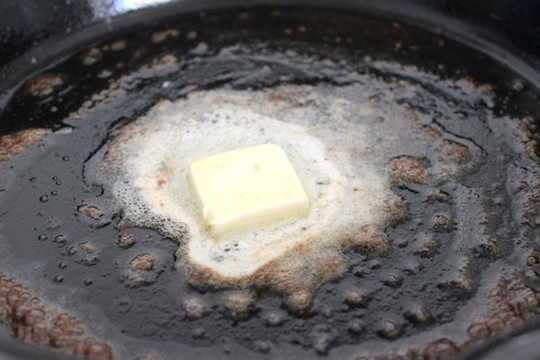
Swirl it around the skillet, when it’s mostly melted add the maple syrup.
Add the escarole. It probably won’t all fit in the skillet at once. Let the first batch wilt a little bit, then add the rest. Sauté, stirring frequently, for 5 to 8 minutes until the leaves are tender but not totally limp. Overcooked escarole tends to be soggy or even slimy, so get it out of the skillet sooner rather than later.
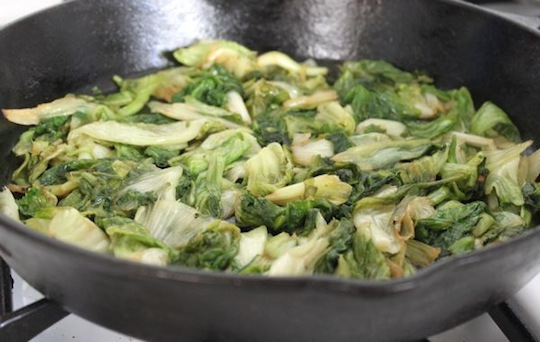
Finish the pork and escarole with a sprinkle of sea salt.

Get All Three Primal Cookbooks, an Apron and More in The Primal Blueprint Chef Kit Today!

Mark Sisson's Blog
- Mark Sisson's profile
- 199 followers



